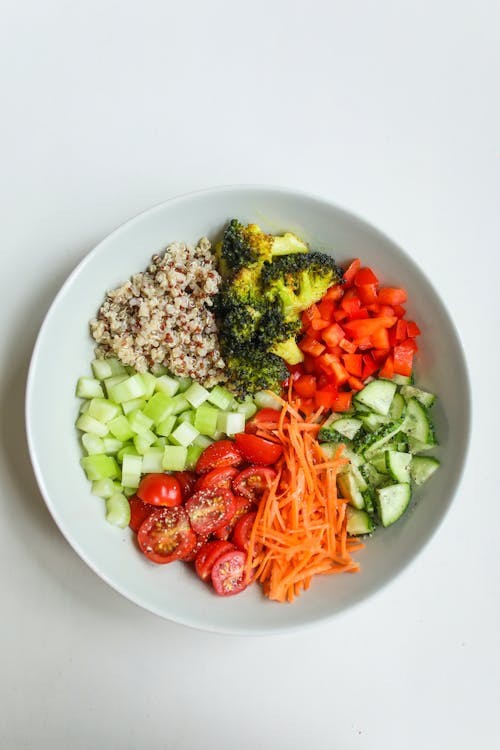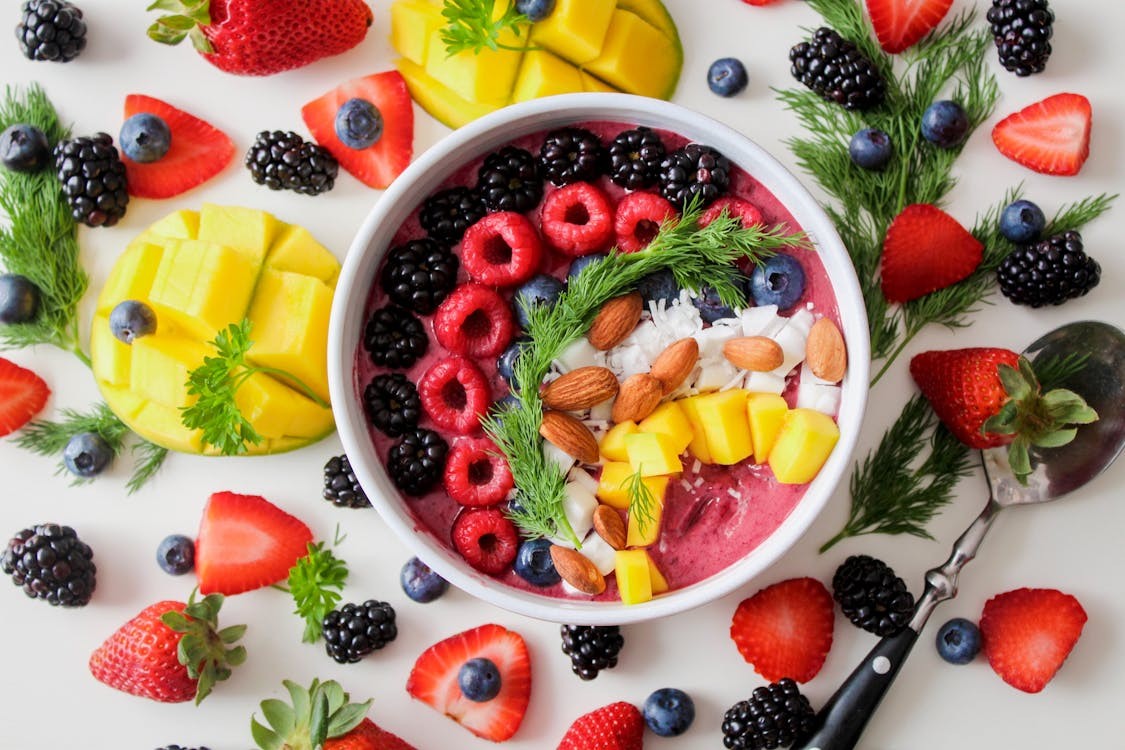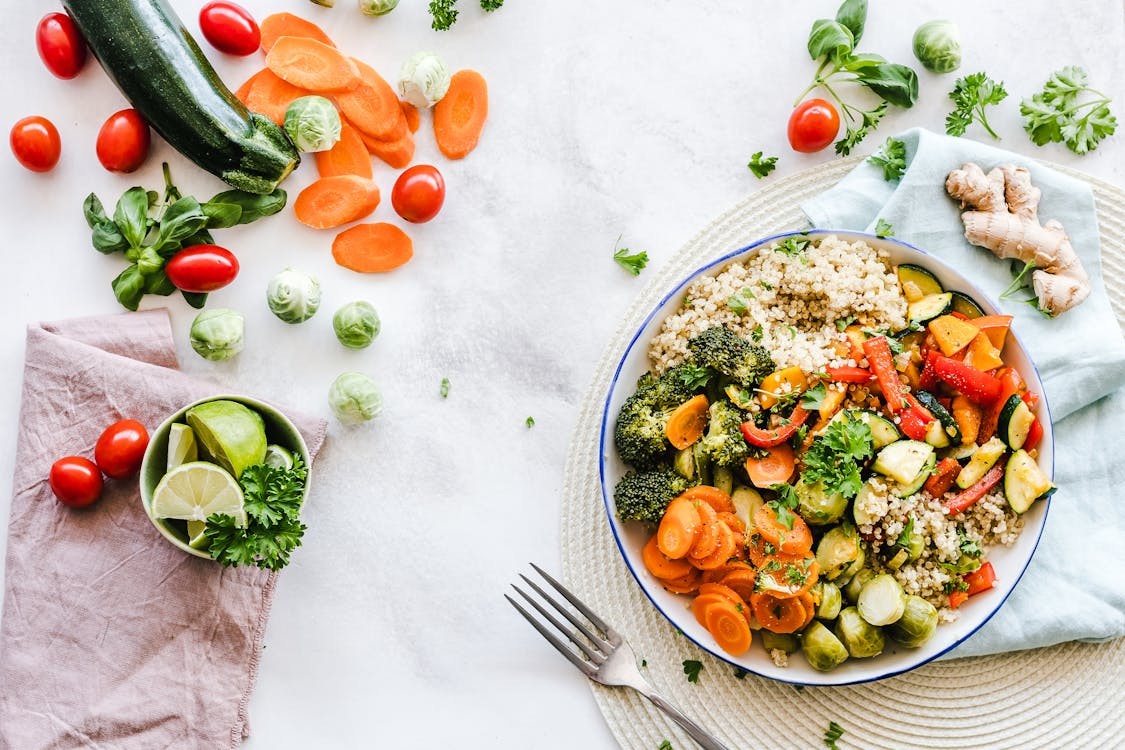What Is Considered Healthy Food? It’s a question on many minds, and at FOODS.EDU.VN, we’re dedicated to providing clear, reliable answers. In essence, healthy food provides the nutrients your body needs to function optimally. Dive into this guide to explore dietary guidelines, practical tips, and the science behind nutritious eating, unlocking a world of vibrant health and well-being. Learn to navigate food choices with confidence, understanding the vital role of balanced nutrition, mindful eating, and the power of informed decisions.
1. Understanding the Foundation of Healthy Eating
What is considered healthy food at its core? Healthy eating is about nourishing your body with the right balance of nutrients to thrive. It’s not about restrictive diets or deprivation, but rather about making informed food choices that support your overall health and well-being. This involves understanding the fundamental food groups and their roles in maintaining a healthy body.
1.1. The Key Components of a Balanced Diet
A balanced diet encompasses a variety of food groups, each offering unique benefits. These include:
-
Fruits and Vegetables: These are rich in vitamins, minerals, antioxidants, and fiber. Aim for at least five servings a day. According to the World Health Organization, consuming at least 400g (five portions) of fruits and vegetables daily reduces the risk of noncommunicable diseases (NCDs).
-
Whole Grains: These provide complex carbohydrates, fiber, and essential nutrients. Examples include brown rice, quinoa, oats, and whole-wheat bread.
-
Lean Proteins: Crucial for building and repairing tissues, proteins can be sourced from poultry, fish, beans, lentils, tofu, and lean meats.
-
Healthy Fats: Unsaturated fats, found in avocados, nuts, seeds, and olive oil, support brain health and hormone production. Avoid trans fats and limit saturated fats.
-
Dairy or Dairy Alternatives: These provide calcium and vitamin D, essential for bone health. Opt for low-fat or non-dairy alternatives if needed.
1.2. Understanding Macronutrients and Micronutrients
To truly grasp what is considered healthy food, it’s vital to understand macronutrients and micronutrients. Macronutrients are the nutrients your body needs in larger amounts, providing energy and supporting bodily functions. Micronutrients, on the other hand, are needed in smaller quantities but are equally crucial for health.
| Nutrient Type | Examples | Benefits |
|---|---|---|
| Macronutrients | Carbohydrates, Proteins, Fats | Energy production, tissue repair, hormone regulation |
| Micronutrients | Vitamins (A, C, D, etc.), Minerals (Iron, Zinc) | Immune function, bone health, nerve function, enzyme activity. According to the World Health Organization, micronutrients are essential for overall health. |





1.3. The Importance of Portion Control and Mindful Eating
Even the healthiest foods can contribute to weight gain if consumed in excess. Portion control is key to maintaining a healthy weight. Mindful eating, which involves paying attention to your body’s hunger cues and savoring each bite, can also help prevent overeating. Studies have shown that mindful eating practices can lead to better weight management and improved overall dietary habits.
2. Diving Deeper into Food Groups: Making Smart Choices
What is considered healthy food also depends on making smart choices within each food group. Not all foods are created equal, and selecting nutrient-rich options is essential.
2.1. Fruits and Vegetables: Maximizing Nutrient Intake
When it comes to fruits and vegetables, variety is key. Each color represents different vitamins, minerals, and antioxidants.
-
Berries: Packed with antioxidants and fiber.
-
Leafy Greens: Rich in vitamins A, C, and K.
-
Cruciferous Vegetables: Broccoli, cauliflower, and Brussels sprouts contain compounds that may help prevent cancer.
-
Brightly Colored Fruits and Vegetables: Such as bell peppers, carrots, and tomatoes, are high in antioxidants and vitamins.
2.2. Grains: Choosing Whole Over Refined
Whole grains are a far better choice than refined grains because they retain the bran and germ, which are packed with fiber and nutrients.
-
Whole Wheat Bread: Provides more fiber than white bread.
-
Brown Rice: A good source of complex carbohydrates and fiber.
-
Oats: High in soluble fiber, which can help lower cholesterol.
-
Quinoa: A complete protein, containing all nine essential amino acids.
2.3. Proteins: Opting for Lean Sources
Lean protein sources are essential for muscle building and overall health.
-
Poultry: Chicken and turkey are excellent sources of lean protein.
-
Fish: Rich in omega-3 fatty acids, which are beneficial for heart health. The American Heart Association recommends eating fish at least twice a week.
-
Beans and Lentils: Plant-based proteins that are also high in fiber.
-
Tofu: A versatile plant-based protein source.
2.4. Fats: Emphasizing Unsaturated Fats
Unsaturated fats are essential for brain health and hormone production.
-
Avocados: Rich in monounsaturated fats and fiber.
-
Nuts and Seeds: Provide healthy fats, protein, and fiber.
-
Olive Oil: A healthy cooking oil rich in monounsaturated fats.
-
Fatty Fish: Such as salmon and tuna, are high in omega-3 fatty acids.
2.5. Dairy and Alternatives: Prioritizing Calcium and Vitamin D
Dairy products provide calcium and vitamin D, but it’s essential to choose low-fat options.
-
Low-Fat Milk: A good source of calcium and vitamin D.
-
Yogurt: Provides probiotics, which are beneficial for gut health.
-
Cheese: Choose low-fat varieties and consume in moderation.
-
Dairy Alternatives: Such as almond milk, soy milk, and oat milk, can be fortified with calcium and vitamin D.
3. Decoding Food Labels: Making Informed Choices
What is considered healthy food also requires the ability to decode food labels. Understanding what you’re putting into your body is crucial for making informed choices.
3.1. Understanding Nutrition Facts Panels
The Nutrition Facts panel provides essential information about the nutritional content of a food product. Pay attention to:
-
Serving Size: All the information on the label is based on this serving size.
-
Calories: The number of calories per serving.
-
Macronutrients: The amounts of fat, carbohydrates, and protein per serving.
-
Micronutrients: The percentages of daily values for vitamins and minerals.
-
% Daily Value (%DV): Indicates how much of a nutrient is in a serving of food, based on a 2,000-calorie diet.
3.2. Identifying Hidden Sugars and Unhealthy Fats
Many processed foods contain hidden sugars and unhealthy fats. Look out for:
-
Added Sugars: Ingredients like high fructose corn syrup, sucrose, and dextrose.
-
Trans Fats: Often listed as “partially hydrogenated oil.”
-
Saturated Fats: Found in high amounts in fatty meats and processed foods.
3.3. Navigating Ingredient Lists
The ingredient list is ordered from the most abundant to the least abundant ingredient. Look for whole, recognizable ingredients at the top of the list.
4. Practical Tips for Building a Healthy Diet
What is considered healthy food in practice? Here are some practical tips to help you build a healthy diet:
4.1. Meal Planning and Preparation
Planning your meals in advance can help you make healthier choices and avoid impulse decisions. Prepare your meals at home to control ingredients and portion sizes.
4.2. Smart Snacking Strategies
Snacking can be part of a healthy diet if you choose wisely. Opt for:
-
Fruits and Vegetables: Such as apples, bananas, carrot sticks, and celery.
-
Nuts and Seeds: A handful of almonds or walnuts.
-
Yogurt: Plain yogurt with berries.
-
Hard-Boiled Eggs: A good source of protein.
4.3. Cooking Techniques for Healthier Meals
How you cook your food can significantly impact its nutritional value.
-
Steaming: Preserves nutrients better than boiling.
-
Baking: A healthier alternative to frying.
-
Grilling: Adds flavor without adding extra fat.
-
Sautéing: Use a minimal amount of healthy oil.
4.4. Hydration: The Importance of Water
Water is essential for overall health. Aim to drink at least eight glasses of water a day. Proper hydration supports digestion, nutrient absorption, and overall bodily functions.
4.5. Eating Out: Making Healthy Choices
Eating out doesn’t have to derail your healthy eating habits.
-
Choose Wisely: Opt for grilled or baked dishes over fried options.
-
Control Portions: Order smaller portions or share a meal.
-
Ask for Modifications: Request dressings and sauces on the side.
5. Addressing Common Dietary Concerns
What is considered healthy food can vary based on individual needs and concerns. Here’s how to address some common dietary issues:
5.1. Managing Allergies and Intolerances
If you have food allergies or intolerances, it’s crucial to carefully read food labels and avoid trigger foods. Work with a healthcare professional or registered dietitian to ensure you’re meeting your nutritional needs.
5.2. Dietary Restrictions: Vegetarianism and Veganism
Vegetarian and vegan diets can be healthy, but it’s essential to ensure you’re getting all the necessary nutrients. Pay attention to:
-
Protein: Include plant-based protein sources like beans, lentils, tofu, and quinoa.
-
Iron: Consume iron-rich foods like spinach, lentils, and fortified cereals.
-
Vitamin B12: Supplement if necessary, as it’s primarily found in animal products.
-
Omega-3 Fatty Acids: Include flaxseeds, chia seeds, and walnuts in your diet.
5.3. Eating for Specific Health Conditions
Certain health conditions may require specific dietary modifications. Work with a healthcare provider or registered dietitian to develop a personalized eating plan.
6. The Role of Physical Activity in a Healthy Lifestyle
What is considered healthy food is only one piece of the puzzle. Physical activity is equally important for overall health. Aim for at least 150 minutes of moderate-intensity or 75 minutes of vigorous-intensity aerobic activity per week. Regular exercise can help:
-
Maintain a Healthy Weight: Burn calories and build muscle.
-
Improve Cardiovascular Health: Lower blood pressure and cholesterol.
-
Boost Mood: Release endorphins, which have mood-boosting effects.
-
Strengthen Bones and Muscles: Reduce the risk of osteoporosis and falls.
7. Debunking Common Nutrition Myths
What is considered healthy food can be confusing due to the abundance of conflicting information. Let’s debunk some common nutrition myths:
Myth 1: Carbs Are Bad for You
Fact: Not all carbs are created equal. Whole grains, fruits, and vegetables provide essential nutrients and fiber. Refined carbs, like white bread and sugary snacks, should be limited.
Myth 2: Fat Makes You Fat
Fact: Healthy fats, like those found in avocados and nuts, are essential for overall health. It’s unhealthy fats, like trans fats and excessive saturated fats, that can contribute to weight gain.
Myth 3: You Need to Detox to Be Healthy
Fact: Your body has its own natural detoxification system – the liver and kidneys. A healthy diet and lifestyle support these organs in their function.
Myth 4: Eating After 7 PM Causes Weight Gain
Fact: It’s not about when you eat, but how much you eat throughout the day. If you’re consuming more calories than you’re burning, you’ll gain weight, regardless of the time of day.
Myth 5: All Calories Are Created Equal
Fact: While calories are a measure of energy, the nutritional value of those calories varies greatly. 100 calories from broccoli are much more beneficial than 100 calories from a candy bar.
8. Building a Healthy Plate: Visual Guides
What is considered healthy food can be easily visualized with a healthy plate model.
8.1. The USDA’s MyPlate
MyPlate is a visual guide that divides your plate into sections:
-
Vegetables: Fill half your plate with vegetables.
-
Fruits: Make fruit a quarter of your plate.
-
Grains: Make grains a quarter of your plate, opting for whole grains.
-
Protein: Include lean protein sources.
-
Dairy: Choose low-fat dairy or dairy alternatives.
8.2. The Harvard Healthy Eating Plate
The Harvard Healthy Eating Plate is similar to MyPlate but includes a few key differences:
-
Healthy Oils: Emphasizes the importance of healthy oils like olive oil.
-
Water: Recommends drinking water throughout the day.
-
Limit Dairy: Suggests limiting dairy consumption.
9. Staying Motivated on Your Health Journey
What is considered healthy food is a lifelong journey, and staying motivated is key.
9.1. Setting Realistic Goals
Start with small, achievable goals. Instead of trying to overhaul your entire diet overnight, focus on making one or two changes each week.
9.2. Finding Support
Surround yourself with supportive friends and family. Consider joining a support group or working with a health coach.
9.3. Celebrating Successes
Acknowledge and celebrate your accomplishments, no matter how small. This will help you stay motivated and build momentum.
9.4. Being Kind to Yourself
Everyone slips up from time to time. Don’t beat yourself up over it. Just get back on track with your next meal or snack.
10. The Future of Healthy Eating: Emerging Trends
What is considered healthy food is constantly evolving as new research emerges. Here are some emerging trends in healthy eating:
10.1. Personalized Nutrition
Personalized nutrition involves tailoring your diet to your individual needs based on genetics, lifestyle, and health goals.
10.2. Plant-Based Eating
Plant-based diets are becoming increasingly popular due to their health benefits and environmental sustainability.
10.3. Gut Health
Gut health is gaining recognition as a key factor in overall health. Probiotics and prebiotics are being studied for their potential benefits.
10.4. Sustainable Eating
Sustainable eating focuses on choosing foods that are environmentally friendly and support local farmers and producers.
FAQ: Your Questions About Healthy Food Answered
1. What is considered healthy food for weight loss?
Healthy foods for weight loss include lean proteins, high-fiber carbohydrates, and healthy fats. Focus on whole, unprocessed foods and portion control.
2. What are the benefits of eating healthy food?
The benefits of eating healthy food include improved energy levels, better sleep, reduced risk of chronic diseases, and enhanced mood.
3. How can I start eating healthier today?
Start by making small changes, such as adding a serving of fruits or vegetables to each meal, switching to whole grains, and drinking more water.
4. What are some examples of healthy snacks?
Healthy snack examples include fruits, vegetables, nuts, seeds, yogurt, and hard-boiled eggs.
5. Is organic food healthier than conventional food?
Organic food may have some nutritional advantages, but the most important thing is to eat a variety of fruits and vegetables, whether they’re organic or conventional.
6. What should I eat before and after a workout?
Before a workout, eat a combination of carbohydrates and protein, such as a banana with peanut butter or a yogurt with berries. After a workout, focus on protein and carbohydrates to help repair and replenish muscles.
7. How can I make healthy eating affordable?
Plan your meals, buy in bulk, cook at home, and choose seasonal produce to make healthy eating more affordable.
8. What are some healthy meal ideas for busy weeknights?
Healthy meal ideas for busy weeknights include stir-fries, sheet pan dinners, and one-pot meals.
9. How can I get my kids to eat healthier?
Involve your kids in meal planning and preparation, offer a variety of healthy options, and lead by example.
10. What is the role of supplements in a healthy diet?
Supplements can fill nutritional gaps, but they should not replace a healthy diet. Consult with a healthcare provider or registered dietitian before taking any supplements.
Embarking on a journey towards healthier eating is an investment in your well-being. By understanding what is considered healthy food and implementing these practical tips, you can nourish your body and mind for a vibrant, fulfilling life. At FOODS.EDU.VN, we are committed to providing you with the knowledge and resources you need to make informed food choices.
Ready to take your culinary journey to the next level? Explore FOODS.EDU.VN for a wealth of in-depth articles, delicious recipes, and expert advice on everything from mastering cooking techniques to understanding the science behind nutrition. Whether you’re a seasoned chef or a kitchen novice, our comprehensive resources will empower you to create meals that nourish your body and delight your taste buds.
Have questions or need personalized guidance? Don’t hesitate to reach out!
Address: 1946 Campus Dr, Hyde Park, NY 12538, United States
WhatsApp: +1 845-452-9600
Website: FOODS.EDU.VN
Unlock the secrets to a healthier, happier you with foods.edu.vn – your trusted partner in culinary excellence.